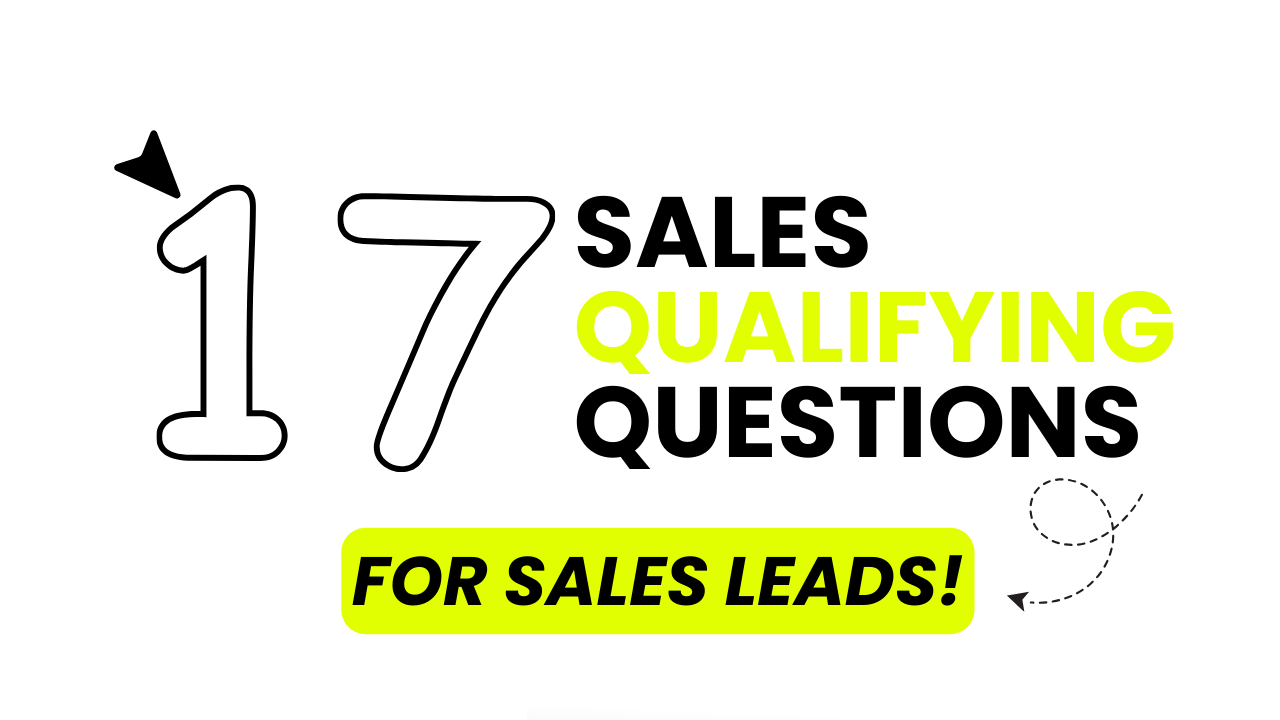The reality of sales is as straightforward as it gets: not every person you talk to is going to turn into a win.
We all know that, but…
How do you separate the contenders from the pretenders?
How do you tell who’s really going to buy and who’s just window-shopping?
What’s the secret?
Well, the secret is:
A set of direct, well-crafted sales qualifying questions.
You see, it’s not about fancy words or long-winded chats.
It’s about straight talk – finding out if what you’re selling and what they need line up perfectly.
- Does your offering solve a problem they actually have?
- Is this the moment they’re ready to make a change?
- Do the numbers align with their budget?
With the right questions, any salesperson can turn a maybe into a yes.
However, these aren’t just any questions.
They’re the golden questions. The ones that open doors and build bridges. And, we’ve got those golden saeles qualifying questions ready for you!
They’re designed to change your game, making it easy to identify those leads who are as serious about doing business as you are.
By the end of this blog guide, you’ll be equipped to separate the most promising prospects from the crowd with confidence, paving the way for successful sales engagements and real results.
So, without further ado, let’s jump right in!
Summary
Before diving deep into the questions you should ask to sharpen your sales strategy, let’s get a bird’s-eye view of what’s ahead.
This blog post isn’t just a list, it’s a toolkit designed for the modern salesperson who is all about action and results.
You’ll learn not only the ‘what’ but also the ‘how’ of qualifying leads—because knowing the right questions is half the battle, but asking them effectively is what wins the war.
By the end, you’ll have a clear understanding of which leads are likely to flourish into partnerships and which ones to let go.
Ready to elevate your approach?
Let’s get started.
What is considered a Qualified Lead?
Understanding what constitutes a qualified lead is fundamental in the sales process.
In essence, qualified leads are leads who tick all the boxes on your ‘ideal customer’ checklist.
A qualified lead is a potential customer who has been assessed and deemed fit for the next step in the sales cycle.
This assessment is based on specific criteria such as their:
- need for your product or service,
- authority to make purchasing decisions,
- budget to afford it,
- and their readiness to buy within a reasonable timeframe.
Essentially, a qualified lead is someone who has the potential to turn into a paying customer because they have a genuine interest in what you’re offering, the means to buy it, and the decision-making power to make it happen.
With these criteria in check, a sales lead moves from just being a name in a database to a valuable opportunity worth pursuing.
What are Sales Qualifying Questions?
Sales qualifying questions are the probing tools used by savvy sales professionals to identify if a lead is a good fit for their product or service.
They are the questions that help you determine whether a potential customer has the need, budget, authority, and timeline that align with what you’re selling.
These questions go beyond surface-level inquiries, they delve into understanding the prospect’s business pains, priorities, and purchasing process.
The essence of these questions is not just to gather information, but to establish a dialogue that uncovers the lead’s current situation and future needs.
The answers to these questions allow a salesperson to tailor their pitch, so it resonates with the prospect’s unique challenges and goals.
They are strategic, structured, and insightful, designed to qualify a lead in or out effectively.
Ultimately, sales qualifying questions serve a dual purpose:
1. They save time by focusing efforts on leads with the highest conversion potential
2. They enhance the customer experience by ensuring that your solution is relevant to their problems.
When used correctly, they are a powerful element of the sales process that contributes significantly to achieving sales targets.
How to formulate Sales Qualifying Questions so you get the most value from them?
Formulating questions to extract maximum value is an art – a tactical game of chess where each move must be precise and thoughtful.
The objective is to elicit information that paints a clear picture of the prospect’s needs and the context of those needs.
Here are 8 principles to keep in mind when formulating sales qualifying questions:
1. Be Specific: Generic questions get generic answers. Tailor your questions to elicit specific information that reveals the prospect’s pain points and needs.
2. Open-Ended for Depth: Use open-ended questions that cannot be answered with a simple ‘yes’ or ‘no’. This encourages the prospect to share more about their situation.
3. Focus on ‘Why’ and ‘How’: Instead of just ‘what’ and ‘when’, ask ‘why’ they need a solution and ‘how’ they intend to use it. This can reveal their motivations and urgency.
4. Balance: While you want detailed information, ensure your questions are balanced and not too intrusive. The conversation should feel natural, not like an interrogation.
5. Prioritize: Identify which pieces of information are most important to qualification and prioritize those in your questioning.
6. Align with Customer Journey: Frame your questions based on the prospect’s stage in the customer journey to ensure relevancy.
7. Encourage Storytelling: Phrasing questions to encourage the prospect to tell a story about their experiences can yield valuable insights.
8. Be Adaptive: Listen actively and be prepared to adapt your questions based on the responses you receive. Sometimes the best questions are those that follow up on what the prospect has just said.
By formulating your sales qualifying questions with these principles, you turn each interaction into an opportunity to learn valuable insights that can guide the prospect towards a decision, while also positioning yourself as a knowledgeable and consultative salesperson.
Remember, the ultimate goal of your questions should be to qualify the lead in a way that feels natural and conversational, not like an interrogation.
Each question should build on the last, creating a narrative that leads to a clear understanding of whether this lead can and should transition into a viable opportunity.
17 Sales Qualifying Questions For Sales Leads in 2023!
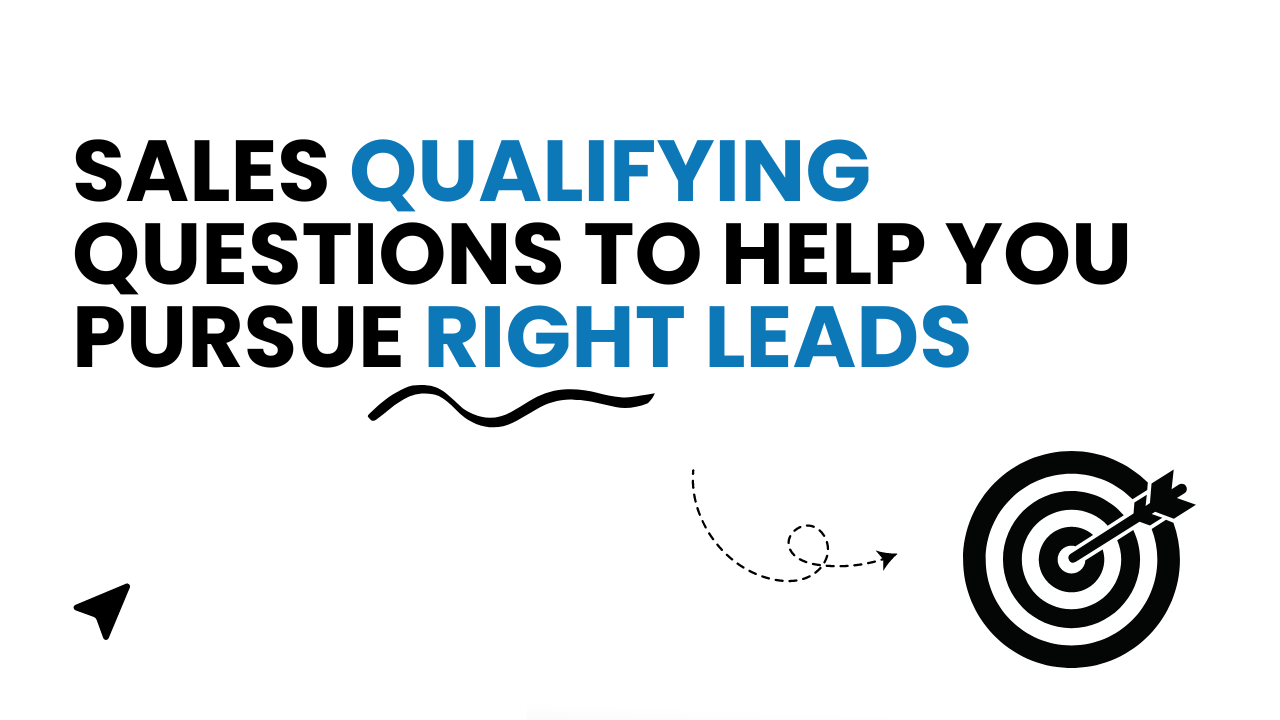
With the groundwork laid and the tools at hand, it’s time to dive into the very core of sales qualification: asking the right questions.
We’re about to step into the practical side of things, where theories meet real-world scenarios.
In the following sections, we unpack the 17 pivotal sales qualifying questions that hold the power to filter through the noise and zone in on potential success stories for your business in 2023.
These aren’t just questions; they’re the keys to unlocking a wealth of information that can transform prospects into profitable partnerships.
Get ready to delve into each question, dissect its purpose, and understand how it fits into the grander scheme of your sales strategy.
This is where we turn curiosity into conversion, inquiry into insight, and conversations into closed deals. Let’s start.
Question #1 “What Prompted You To Reach Out To Us Today?”
When you kick off your conversation with a lead, this question serves as the perfect opener.
It’s disarmingly simple but incredibly potent.
This inquiry gets straight to the heart of the matter, revealing the driving force behind the prospect’s action to contact your company.
Why This Question Works:
It immediately sets the stage for the prospect to share the most pressing issue or need that brought them to your doorstep.
Whether it’s a problem they’re trying to solve, a goal they’re aiming to achieve, or merely a curiosity sparked by your marketing, their answer provides a wealth of context.
It helps you understand their current situation and mindset, allowing you to tailor the conversation accordingly.
Strategic Timing and Approach:
This sales qualifying question should be your conversational gambit, the first major play you make.
It’s non-threatening and encourages the prospect to open up.
The key here is to listen—not just to what they say but to how they say it.
Their tone, their choice of words, and the details they prioritize can all clue you in on their sense of urgency and their emotional investment in the problem or need they’re facing.
Utilizing the Response:
The way your lead responds gives you immediate insight into several aspects:
- their awareness of their own needs
- their perception of your company’s potential to help
- and the immediacy of their problem
With this information, you can navigate the conversation toward how your product or service can meet the needs they’ve expressed or solve the problem they’re facing.
Remember, your response should acknowledge what they’ve shared and affirm that they’ve come to the right place.
It establishes the initial connection on which the rest of the conversation will build.
By understanding their ‘why’ right from the get-go, you can steer the rest of your questions to align with their motivations, creating a personalized and engaging sales dialogue.
Question #2 “How Did You Hear About Us?”
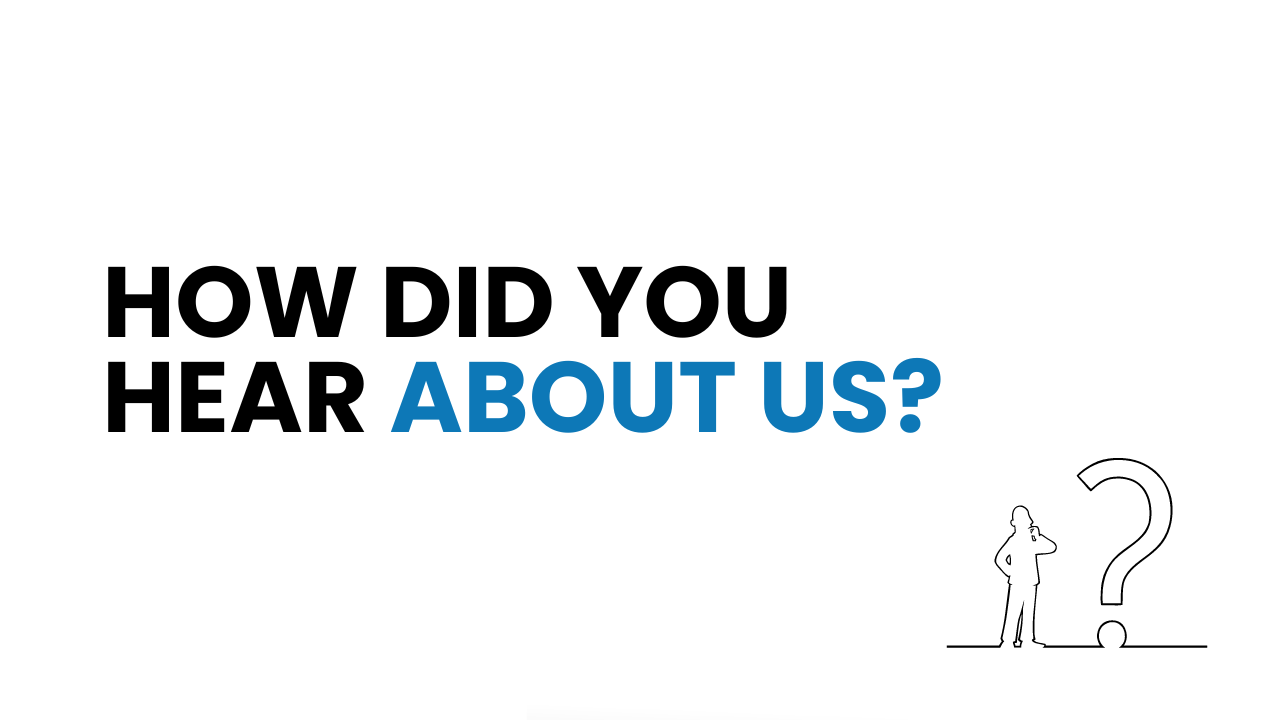
Diving deeper into the conversation, this question is an essential follow-up.
It provides insight into the pathways that are bringing potential customers to your company, which is valuable information for your marketing and sales strategies.
The Insight This Question Provides:
When you ask, “How did you hear about us?” you’re essentially tracing the steps the prospect took to find you.
Was it through a Google search, a recommendation from a colleague, social media, or perhaps an advertisement?
This information helps you not only in qualifying the lead but also in refining your marketing strategies.
When to Ask This Question:
This question fits naturally after the initial ask about their reason for reaching out.
It’s a seamless follow-up that feels conversational and shows genuine interest in the prospect’s experience.
It’s casual enough not to put pressure on the prospect yet strategic enough to provide actionable data that can help you refine your marketing efforts.
Why It’s Crucial for Sales Strategy:
The answer guides you on how to approach the conversation.
For instance, if they heard about you through a detailed blog post, they might appreciate a more informative, content-rich discussion.
If a friend referred them, then there’s an element of trust already established that you can build upon.
Moreover, knowing the marketing touchpoint that led them to you can help personalize their journey further, making them feel valued and understood.
Using Their Answer to Your Advantage:
This question isn’t just a means to an end, it’s part of the relationship-building process.
If they came through a certain channel, it hints at the kind of content and messaging that resonates with them, which is incredibly valuable in guiding the sales process.
You can leverage this knowledge to connect their discovery pathway to the solutions you offer, creating a narrative that reinforces the validity of their journey and your ability to fulfill their needs.
Question #3 “Can You Tell Me A Bit About Your Business And Your Role?”
With this straightforward ask, we’re peeling back the layers to see the core of who we’re talking to and what battlefield they’re navigating.
It’s about getting the lay of their land and understanding where they stand in it.
Peek Behind the Curtain:
This isn’t just chit-chat.
You’re digging for the gold that’s often hidden in the every day – what does their company do, and how does the person in front of you fit into that picture?
The nuggets of information you get here are prime material for crafting a solution that feels like it was made just for them.
Lead enrichment can also help with this.
Timing is Key:
Slide this question in after you’ve warmed up with the initial niceties.
It’s an organic pivot from understanding how potential customers found you to explore their world.
The Strategy:
Knowing the business terrain and the prospect’s rank in their troop helps you tailor your tactics.
If they’re calling the shots, you’ll want to come armed with strategy and stats.
If they’re in the trenches, it’s all about tools and tricks to make their life easier.
Make it Work for You:
The details they serve up can help you customize your pitch.
You can echo their language, refer to specific challenges they face, and make them see your product or service as the missing puzzle piece they’ve been looking for.
It’s about creating that ‘aha’ moment for them, where everything clicks.
Question #4 “What Challenges Are You Currently Facing”
This query cuts to the chase.
It’s the kind of question that invites the prospect to open up about the hurdles they’re trying to leap over.
Here, you’re offering them a chance to lay out the obstacles on their track.
Straight to the Heart of the Matter:
Challenges are the bread and butter of any sales dialogue.
By understanding the trials your prospect faces, you can better position your offering as the solution.
This question sets the stage for empathy and shows you’re there to help, not just to sell.
Seamless Progression:
After establishing who they are and what their company does, inquiring about their challenges is the natural next step.
It feels less like prying and more like concern, helping to fortify that crucial salesperson-prospect relationship.
Strategic Empathy:
Being clued into your prospect’s pain points gives you the chance to show that you’re not only listening but also that you genuinely want to solve their problems.
This is where you switch from selling to consulting, from offering a product to providing a remedy.
Turning Challenges into Opportunities:
With the intel you gather from their response, you can begin to weave your product or service into the narrative as the hero they’ve been waiting for.
It’s about painting a picture where you and your offering fit seamlessly into their quest to conquer challenges.
Question #5 “How Are These Challenges Affecting Your Business/Operations?”
This question digs into the ripple effects of the challenges they’re facing.
It’s not just about identifying the hurdles; it’s about understanding the impact they have on the prospect’s daily grind.
Mapping the Impact:
You’ve heard their challenges.
Now it’s time to measure their wake.
This is where you discover the reach of the problem, whether it’s a stone’s throw or a marathon away from affecting their bottom line.
Strategic Insight:
Knowing how these issues bleed into their business gives you the leverage to position your products and services as a tourniquet, not just a Band-Aid.
It’s one thing to say you can solve a problem, it’s another to demonstrate how your products and services can alleviate its effects.
A Cue for Compassion:
When they share how these challenges affect their operations, it’s a moment for you to listen, really listen.
This isn’t just about gathering information, it’s about showing that you care, and that you’re here to offer more than just a product or service.
Leveraging Pain Points:
With each detail of how their issues are impacting their business, you’re collecting ammunition.
With it, you can aim your solution directly at the heart of the disruption, proving that your offering isn’t just valuable—it’s vital.
As you dissect the nuances of their struggles, you lay the foundation for a solution tailored not just to the problem, but to the story behind it.
This isn’t about a one-size-fits-all answer; it’s about crafting a key that fits perfectly into the lock of their predicament.
Question #6 “Have You Tried Any Solutions So Far, And How Have They Worked For You?”
Peeling back the layers of their previous attempts at resolution, this inquiry isn’t mere curiosity, it’s an expedition into their history with the problem at hand, including any qualification processes they’ve used.
Uncovering History to Write the Future:
By understanding their past solutions, you grasp more than just what’s been done—you glean the insights into what worked, what faltered, and why. It’s a golden gouse of learning, ripe for the picking.
Insight into Preferences and Biases:
Their experiences with past solutions often leave a taste – bitter or sweet.
You’re getting a read not just on past products but on expectations and experiences that have shaped their viewpoint.
This is invaluable for positioning your offering and understanding their qualification criteria.
Avoiding the Landmines of the Past:
Each previous attempt that didn’t stick is a landmine you can now sidestep.
Knowledge of these pitfalls informs your pitch, allowing you to highlight how your solution isn’t just different, but better.
Building on Foundations, Not Rubble:
If they’ve had success stories, you’re not starting from scratch.
You’re building on a foundation.
If it’s been a series of misfires, you’re offering a new beginning.
Either way, you’re not walking in blind—you’re guided by their history.
This question is not just about past solutions.
It’s about understanding their journey, their decisions, and most importantly, their readiness to embrace a new solution that you’re bringing to the table.
It’s a step towards creating a narrative that your solution is not just another option, but the next chapter in their story of overcoming challenges.
Question #7 “On A Scale Of 1 To 10, How High A Priority Is Solving This Issue For You Right Now?”
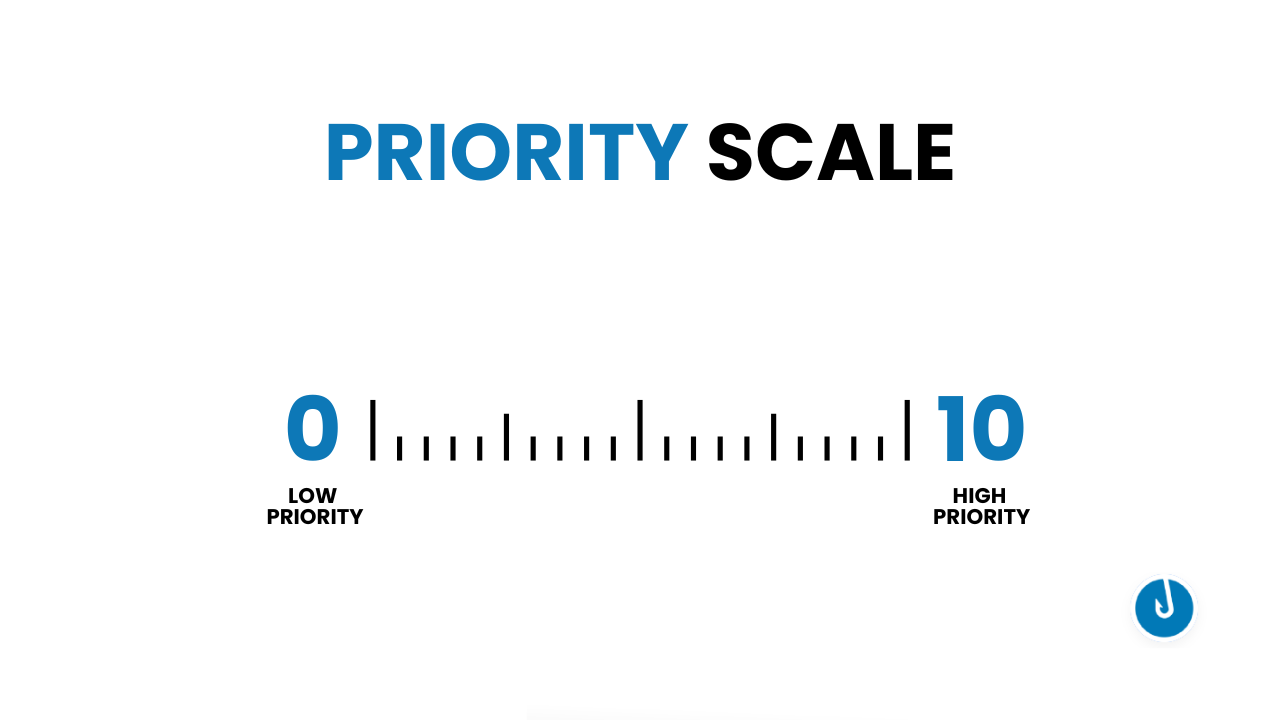
This straight-to-the-point question does the heavy lifting in gauging a prospect’s commitment level to finding a solution. It’s your quick thermometer check on how hot the issue is for them at this very moment.
Assessing Urgency:
The response here serves as a clear indicator of how urgent the problem is.
A 10 means you’re dealing with someone who’s feeling the heat and needs a solution yesterday.
A lower number?
That suggests there’s breathing room and maybe less immediate drive to act.
Setting the Stage for Action:
Knowing where they stand on this scale tells you how to pace the conversation.
High urgency means you can move swiftly to propose solutions.
A lower score suggests you might need to spend more time building the case for your product or service.
Aligning Expectations:
Their answer helps you understand what they expect from you and by when.
If they’re scoring high, they might be looking for swift answers and quick fixes.
Lower scores could mean they’re in the early stages of exploring options.
Filtering Serious Prospects:
Lastly, this question separates those who are just browsing from those who are seriously shopping.
It’s a clear-cut way of identifying how much time and effort you should invest in this lead right now. This is the key for prioritizing sales leads effectively.
In the dance of sales, timing is key.
By asking prospects to rate the importance of solving their problem, you’re not just seeing where the spotlight falls, you’re figuring out how fast the music is playing for them – and that tells you how quickly you should move.
Question #8 “Can You Walk Me Through Your Decision-Making Process When Selecting A Product/Service Like Ours? And Who Are the Decision-Makers Involved in This Process?”
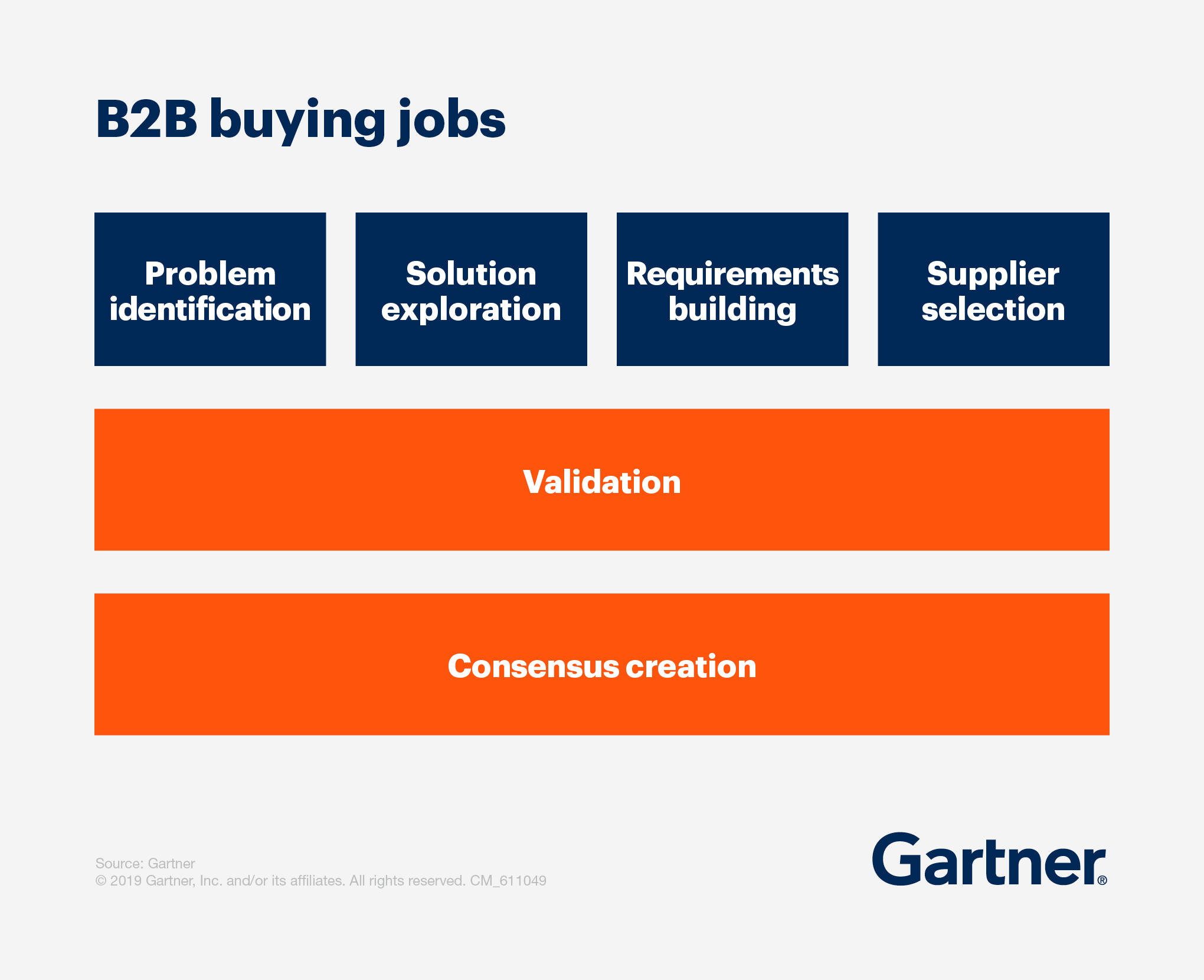
Source: Gartner
Asking a prospect to detail their decision-making process is like asking for the map they use to navigate their choices. It reveals the route they’re likely to take from Point A, where they recognize a need, to Point B, where they make a purchase.
Revealing the Process:
With this question, you’re looking for a rundown of what happens from the moment they realize they need a solution to the point where they sign on the dotted line.
- Do they do a lot of research?
- Is there a committee that weighs in?
- Do they need approval from higher up?
Identifying Key Players:
You also get to uncover who pulls the strings.
Is it the person you’re speaking to, or is there a team that needs to be convinced?
Knowing who’s involved is crucial because it could mean the difference between a streamlined pitch and a multi-layered presentation.
Understanding Timeframes:
This insight gives you a clue about the time it takes for them to make a decision.
Does this process span weeks, months, or is it a matter of days?
This helps you plan your follow-ups and manage your own expectations.
Tailoring Your Approach:
Finally, this knowledge lets you tailor your pitch.
If you know the steps and the people, you can customize your approach to speak directly to the concerns and criteria that matter most to them.
Ask this question, and you’re not just listening to a process, you’re taking notes on how to become a part of it. It’s the smart way to ensure your product or service fits neatly into the picture they paint for you.
Question #9 “What’s Your Ideal Timeline For Implementing Solution”

Timing can be everything when it comes to sealing the deal. Understanding a prospect’s ideal timeline sets the stage for the urgency of the solution you’re offering and how it aligns with their expectations.
The Importance of Timing:
By asking about their timeline, you’re gauging how urgent the need is.
If they’re looking to implement a solution yesterday, you know the pressure is on, and a swift response could win you favor.
On the flip side, if they have a more relaxed timeframe, you have the luxury of nurturing the relationship and building a solid foundation for the future.
Synchronization of Schedules:
Knowing their expected timeline also helps you assess if your own resources and capabilities are in sync.
Can you deliver what they need in the time they expect?
If not, it’s better to know now and manage expectations than to disappoint later.
Planning for Implementation:
Their timeline can also inform you about the prospect’s planning style.
Are they meticulous and forward-thinking, or do they fly by the seat of their pants?
This insight can be invaluable when planning out the implementation phases and post-sale support.
Adjusting Your Pitch:
Lastly, this is your opportunity to adjust your pitch and timelines accordingly.
Can you offer a quicker turnaround? Or do you need to explain the benefits of a longer, more thorough implementation?
So, by asking “What’s your ideal timeline for implementing a solution?” you’re not just asking when; you’re really asking “How serious are you, and how can we best prepare to meet your needs?“
Question #10 “What Is Most Important To You In A Solution – Cost, Quality, Support, Etc.?”
Peeling back the layers of a prospect’s priorities can reveal the core values driving their decision. Is it the price tag that will sway them, the unmatched quality of the product, or the reassurance of stellar support?
Uncovering Core Values:
This question cuts straight to the heart of what the prospect values most.
It’s not just about their budget or their needs, but about what they won’t compromise on.
Knowing this helps you highlight the aspects of your offering that resonate most deeply with them.
Balancing Priorities:
For many, the ideal solution is a balance of factors:
- cost-effectiveness,
- high quality,
- and reliable support.
By understanding their ranking of these elements, you can present a solution that hits the right notes and addresses their primary concerns.
Setting the Stage for Customization:
The answer to this question provides a framework for customization.
It tells you where to add value and how to structure your proposal.
If quality trumps cost, you’ll know to spotlight your product’s superior performance and durability.
If cost is king, you’ll emphasize affordability and ROI.
Crafting a Tailored Narrative:
Finally, their priorities allow you to craft a narrative that speaks directly to what matters to them.
This isn’t about changing your product to fit the customer – it’s about changing the conversation to highlight the fit that already exists.
Asking about priorities empowers you to align your pitch with the prospect’s key decision-making factors, showcasing your solution as the perfect fit for what they value most.
Question #11 “Can You Describe The Key Features Or Capabilities You Are Looking For?”
Getting prospects to articulate the specific features or capabilities they’re seeking is like asking an artist about the colors they need for their palette – it helps you understand what they envision as their masterpiece.
Zeroing in on Expectations:
This question is about nailing down the specifics.
It’s the difference between a vague idea and a clear-cut list of must-haves.
What exactly does the prospect need the product to do?
The details they provide will tell you if your solution can match their expectations.
Aligning Product Strengths:
Once you know the features they’re after, you can align your product’s strengths with their requirements.
If they’re looking for robust analytics and your software has that in spades, you’ll know to bring that to the forefront of your discussions.
Gauging Product Fit:
Understanding the desired capabilities also helps gauge how well your product fits their needs.
If there’s a mismatch, it’s better to know now.
This way, you can either point them towards a more suitable option or explain how your product can still meet their needs in ways they might not have considered.
Customizing the Solution:
Armed with this information, you can tailor your demo or sales pitch to focus on the features they care most about.
It’s about showing them that your product isn’t just a tool – it’s the right tool for the job at hand.
Asking about features and capabilities not only clarifies the prospect’s vision but also demonstrates your commitment to meeting their unique needs, setting the stage for a solution that feels tailor-made.
Question #12 “Have You Set Aside A Budget For This Type Of Solution, And If So, What Is The Range You’ve Considered?”
Inquiring about a budget is akin to setting the stage before the main act – it ensures everyone’s ready for what’s to come. This question isn’t about dollars and cents alone; it’s about aligning expectations and possibilities.
Establishing Financial Framework:
When you understand a prospect’s budget, you establish a financial framework for the conversation.
It’s a candid checkpoint that clarifies whether your solution is within their financial reach and how you can best accommodate their needs within that range.
Navigating Financial Realities:
A clear picture of the budget paves the way for a more grounded discussion.
It helps in navigating the financial realities and prevents the pitfall of proposing solutions that are financially out of scope for the prospect.
Strategizing Solutions:
Knowing the budget range, you can strategically present solutions.
If their budget is tight, you can discuss essential features versus nice-to-haves, or if they have more to spend, you can explore premium offerings.
Facilitating Honest Dialogue:
This query facilitates an honest dialogue around finances, which can often be a sensitive topic.
It shows respect for the prospect’s financial planning and a practical approach to meeting their needs.
Asking about the budget upfront saves time for both parties and sets the tone for a transparent and realistic conversation about how your product or service can deliver value within their financial parameters.
Question #13 “Are You Evaluating Other Solutions Or Vendors? If So, What Are Your Top Considerations?”
Discovering whether your prospect is eyeing other solutions or vendors gives you a glimpse into the competitive landscape from their perspective. It’s not just about who else is in the running, it’s about understanding the criteria driving their evaluation.
Mapping the Competition:
This inquiry helps you map out who you’re up against.
It’s important to know if your prospect is considering alternatives so you can differentiate your offering effectively.
Understanding Decision Factors:
You’ll want to dig into what factors are topping their list.
Is it the features, customer service, pricing, or the reputation of the vendor?
Pinning down their priorities helps you tailor your conversations and highlight aspects of your solution that align with these priorities.
Gauging Commitment Level:
The response to this question also indicates how committed they might be to the purchasing process.
If they’re actively evaluating options, they’re likely further along in the buying cycle, which can inform the urgency and nature of your follow-up.
Preparing Tailored Propositions:
Armed with this knowledge, you can prepare propositions that speak directly to their needs and how you stand out from the alternatives they’re considering.
It’s about crafting a message that resonates with their specific situation.
By understanding where you stand among a prospect’s options, you can better position your product or service as the preferred choice, addressing their concerns and illustrating clear differentiators that set you apart.
Question #14 “How Do You See Our Product/Service Fitting Into Your Current Workflow/Operations?”
Asking a lead how they envision your product or service sliding into their current operations isn’t just forward-thinking – it’s strategic brilliance. It shifts the conversation from hypothetical to practical application, placing your solution within the framework of their daily business rhythm.
Painting the Integration Picture:
This question invites the prospect to paint a picture of how your solution integrates into their existing ecosystem.
You’re asking them to mentally install your product into their workflow, which is a subtle nudge towards imagining a future with your service as part of their process.
Identifying Compatibility and Gaps:
You’ll gather insights on how compatible your solution is with their operations and whether there are any gaps you need to address.
Understanding how they perceive the fit can guide you to customize features or offer additional services that plug into those gaps seamlessly.
Facilitating Custom Solutions:
By visualizing the integration, you can facilitate a custom solution that feels less like a disruptive change and more like a natural progression.
It’s about molding your offering to become a turnkey solution that slips in with minimal friction.
Establishing a Change Management Plan:
Knowing how they see the integration lets you assist in developing a change management plan, ensuring a smooth transition.
You can preemptively tackle any reluctance or operational snags by being one step ahead with solutions.
This question is a potent tool for the salesperson, subtly transforming the prospect from a passive participant into an active co-creator of the solution narrative.
It’s where the rubber meets the road, and a savvy sales lead knows that a prospect who can visualize the solution in action is already halfway down the sales funnel.
Question #15 “Are There Any Internal Or External Challenges You Foresee That Might Hinder The Adoption Or Implementation Of Our Solution?”
Uncovering potential roadblocks early in the conversation is crucial. This question is the equivalent of checking the weather before sailing out – it prepares you for storms ahead and tests the waters of commitment.
Identifying Potential Hurdles:
By probing for internal or external challenges, you’re asking the lead to lay out any possible mines in the field.
Is it a budget constraint, a technical gap, or resistance to change from the team?
Knowing these hurdles beforehand gives you the advantage of strategy.
Crafting Contingency Plans:
Acknowledging these obstacles is the first step to devising a workaround.
If you’re aware of what might throw a wrench in the works, you can come armed with a contingency plan or provide preemptive solutions that ease those concerns.
Building Trust Through Transparency:
Such a conversation also builds trust.
It shows that you’re not just selling a product but are genuinely interested in ensuring its success within their environment.
You’re there to partner with them, not just push a purchase.
Navigating the Buy-in Process:
Understanding challenges can also guide you on how to navigate the buy-in process.
If there are specific influencers or gatekeepers who are skeptical or particular about new solutions, knowing about them upfront helps you tailor your pitch to win them over.
In essence, this question helps in sculpting a more resilient, robust sales approach, as it allows you to brace for and adapt to the unique landscape of the prospect’s organizational ecosystem.
It’s about being prepared to climb the mountains with them, rather than being surprised by the incline.
Question #16 “How Would You Measure The Return On Investment (ROI) For This Solution? What Does Success Look Like To You?”
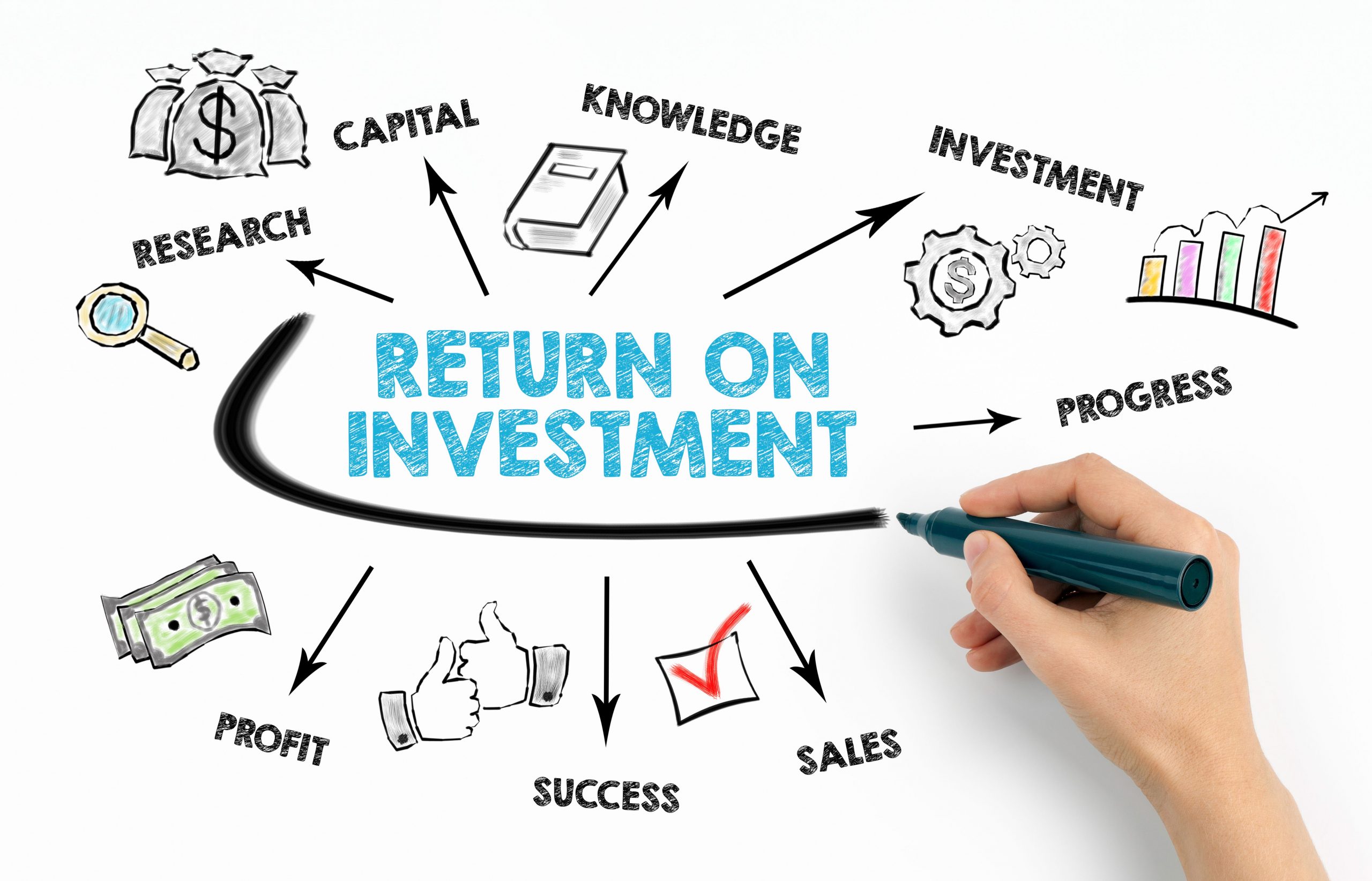
This question gets down to brass tacks.
It’s not just about whether the client likes your product; it’s about whether it makes sense for their bottom line.
You’re digging into their success metrics, which can vary as widely as companies themselves.
Establishing Success Metrics:
Every business has its scoreboard.
For some, it’s increased sales or improved efficiency.
For others, it’s customer satisfaction or market penetration.
This question uncovers what winning looks like for them, providing a blueprint for what you need to deliver.
Aligning Expectations:
It’s also about setting expectations.
If a lead expects an unrealistic ROI, you’ll want to know upfront.
It’s your cue to either adjust their expectations or to step up your solution to meet them.
Quantifying Value:
Quantifying the benefits of your product in terms that resonate with the lead’s objectives is key.
Whether it’s time saved, revenue gained, or costs reduced, you need to speak their language when it comes to value.
Personalizing Your Pitch:
With the ROI perspective clear, you can tailor your pitch to highlight the most relevant benefits of your solution.
If they’re focused on cost-savings, you’ll spotlight that.
If it’s about staying ahead of the competition, you’ll show how your solution gets them there.
By asking this, you’re peering into their strategic goals and drawing a map from your product to their promised land.
It’s a crucial conversation that can make the difference between a closed deal and a missed opportunity.
Question #17 If We Were to Move Forward, What Would Be The Next Steps From Your Side?
Understanding the lead’s next steps is like peering through the keyhole into their world of procedure and protocol.
It’s not just about their interest level, it’s about:
- their readiness,
- their process,
- their practical path to partnership.
Clarifying the Path Forward:
What’s the roadmap from tentative interest to signed, sealed, and delivered?
This question lays out their internal steps, whether it’s convening with a team, securing a budget, or navigating bureaucratic labyrinths.
Identifying Potential Roadblocks:
By pinpointing the stages, you also spot potential snags before they trip you up.
Maybe they have a lengthy vendor onboarding process, or perhaps they need board approval – knowing this shapes your timeline and strategy.
Aligning with Their Pace:
If they’re ready to sprint, you’ll lace up your sneakers.
If it’s a marathon, you’ll pace accordingly.
This synchronization of cadences is crucial to maintain momentum and demonstrate that you’re in tune with their operational beat.
Preparing Your Follow-Up:
Finally, their answer primes your next steps.
It’s the difference between a prompt proposal or giving them the space to prepare.
With their playbook in your hands, you’re better equipped to play ball on their field.
So, as you wrap the conversation with this pivotal question, you’re not just nodding along, you’re sketching the blueprint of a potential partnership, ready to fill in the lines with a tailored, informed approach that aligns perfectly with their expectations and processes.
How can ZeroIn Help you reach your Sales Goals?
In the dance of sales lead qualification, ZeroIn plays your go-to tune.
Picture this:
You’ve got your list of sales qualifying questions fine-tuned and ready to roll.
You know the ins and outs of what makes a lead sizzle with potential.
But here’s the kicker – you need those leads first.
That’s where ZeroIn steps in.
Direct Contact with Decision-Makers:
ZeroIn isn’t about flooding your list with just any contacts, it’s about connecting you directly to decision-makers.
By extracting business emails from LinkedIn, you’re already one step closer to a conversation with someone who can say ‘yes’ to your solution.
Streamline Your Outreach:
Tired of the chase?
Let ZeroIn do the legwork.
When you have a tool that hands you emails that are already vetted, you’re cutting out the middleman.
No more guesswork, no more bounced emails.
Just you, hitting ‘send,’ and knowing your message is on its way to a real person.
Stay Compliant, Stay Trustworthy:
Using ZeroIn means your lead generation tactics are transparent and respectful of privacy laws like the GDPR.
Trust is the foundation of any good sales relationship, and it starts with how you gather your contacts.
Quality over Quantity:
You want leads that convert, not just a list of names.
ZeroIn’s promise of accuracy means that the contacts you get are more likely to be interested in what you’re offering.
It’s about making sure every lead on your list has the potential to tick off all the right boxes in your qualifying questions.
Fit for Your Funnel:
Every salesperson knows their funnel inside out.
ZeroIn feeds into your process, slotting in smoothly to help you fill the top of your funnel with quality leads.
From there, you’re well-equipped to guide them down to the crucial point of conversion.
So, as you rifle through your list of probing questions – from budget to decision-making power, and timelines to ROI – think of ZeroIn as your initial filter.
It helps ensure that the people you’re applying these questions to are the ones worth your time.
It’s your starting block for a race well-run, giving you that head start every salesperson dreams of.
ZeroIn is straightforward – it helps you target your outreach, respect your prospects, and fill your funnel with those who are more likely to become not just leads, but valuable business relationships.
Conclusion
And there you have it – your arsenal of sales qualifying questions for the year is locked and loaded.
We promised a no-nonsense guide, and hopefully, we’ve delivered just that.
Remember, it’s not about having a silver tongue – it’s about the golden questions.
And you’ve got them now.
This isn’t about shooting arrows in the dark.
It’s about precision – knowing who to aim for and when to release.
You’ve got the what, the how, and even the when.
Each question you’ve encountered here is a stepping stone towards understanding your prospects better, saving time, and sealing deals that matter.
We’ve cut through the clutter and laid out the essentials. It’s straightforward: Identify your lead, engage with intent, and gauge their readiness with sales qualifying questions that hit home.
And when in doubt, remember tools like ZeroIn are there to ensure your aim is true from the get-go.
Sales is a game of finesse, played best with clear eyes and a full deck of sharp questions.
So, wield them well, watch for the tell-tale signs of a solid lead, and go forth with the confidence that your next conversation could lead to your next big win.
After all, in sales, the right word at the right time is worth its weight in gold.
And you’re now well-equipped to strike it rich.
FAQs
What is a Qualified Lead?
A qualified lead is someone who fits your ideal customer profile, shows genuine interest in your product or service, has the authority and budget to purchase, and is prepared to buy within your timeline.
They’re not just a contact but a promising opportunity for a sale.
What are Sales Qualifying Questions?
Sales qualifying questions are targeted inquiries that help determine if a lead is likely to become a customer.
They assess a prospect’s need for your offering, ability to purchase, decision-making authority, and timing.
These questions aim to reveal the lead’s specific business challenges and readiness to buy, guiding sales professionals to engage meaningfully and pitch their solutions effectively.
How to formulate sales qualifying questions so you get the most value from them?
Crafting effective sales questions means creating a dialogue that uncovers in-depth insights into a lead’s needs and intentions. To do this, questions should be:
- Specific to gather detailed information.
- Open-ended to encourage elaborate answers.
- Centered on ‘why’ and ‘how’ to uncover motivations.
- Balanced to maintain a conversational tone.
- Prioritized to focus on the most crucial information.
- Relevant to the lead’s stage in the customer journey.
- Designed to encourage storytelling for richer context.
- Adaptive to lead responses for a natural flow.
This approach ensures that you gather the critical information needed to qualify the lead effectively while maintaining an engaging and consultative conversation.
How can ZeroIn Help you reach your Sales Goals?
ZeroIn simplifies your initial step in sales: finding the right people to talk to. With ZeroIn, you get:
Direct Access: Connect with decision-makers whose emails are pulled straight from LinkedIn. This puts you in direct touch with people who have the power to say ‘yes’.
Efficient Outreach: With verified emails at your disposal, you skip the guesswork and avoid the dead-ends of incorrect or outdated information.
Compliance: ZeroIn respects privacy laws like GDPR, starting your sales relationships on a foundation of trust.
Quality Contacts: The high accuracy rate of ZeroIn means you’re reaching out to potential customers who are more likely to need what you’re offering.
Seamless Integration: It fits right into your sales funnel, helping you to populate it with leads that have a better chance of becoming valuable customers.
By using ZeroIn, you’re not just gathering names; you’re strategically setting the stage for meaningful sales conversations. It’s the boost to not only meet but also exceed your sales goals.
